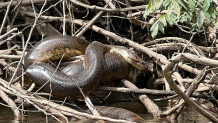Scientists have discovered a previously unknown species of the green anaconda, the largest and heaviest snake species on Earth.
The surprise finding has upended scientific understanding of the green anaconda, long thought to be a single species and now revealed to be two genetically different boa species, despite looking almost identical.
The new species was discovered while filming the National Geographic and Disney+ docseries “Pole to Pole” hosted by Will Smith.
Bryan Fry, a professor at the University of Queensland and lead researcher on the Nat Geo expedition into the Amazon's Orinoco basin, said he and his team were invited by the Waorani people to explore the region and collect samples from a population of anacondas, which they consider sacred. The people of the Waoroni Nation occupy a territory in Ecuador known as the Amazonian provinces of Orellano, Napo and Pastaza, according to Amazon Frontlines.
We're making it easier for you to find stories that matter with our new newsletter — The 4Front. Sign up here and get news that is important for you to your inbox.
Indigenous hunters took them into the jungle on a 10-day trek in search of snakes.
“We paddled canoes down the river system and were lucky enough to find several anacondas lurking in the shallows, lying in wait for prey,” Fry said in a news release. "The size of these magnificent creatures was incredible — one female anaconda we encountered measured an astounding 6.3 metres (20.7 feet) long. There are anecdotal reports from the Waorani people of other anacondas in the area measuring more than 7.5 metres (24.6 feet) long and weighing around 500 kilograms (1,102 pounds)."

That's when researchers began to notice that the green anacondas in this northern region were much larger than those previously found in Brazil. And while they looked nearly identical, genetic samples taken by the researchers later confirmed that were indeed a different species.
The researchers published their findings in the scientific journal MDPI Diversity, and proposed renaming the northern green anaconda Eunectes akayima.
Fry said the northern green anaconda species likely diverged from the southern green anaconda almost 10 million years ago, and the two differ genetically by about 5.5%. "To put it in perspective, humans differ from chimpanzees by only about 2%,” Fry said.
Fry called the discovery "the highlight of my career."
Green anacondas are native to the northern regions of South America and are also found in Peru, Bolivia, Guyana, Paraguay, French Guiana and Trinidad. These constrictors use their strong bodies to suffocate and kill prey before swallowing them whole, according to the Smithsonian National Zoo & Conservation Biology Institute. Green anacondas are also adapted to the aquatic life and their nose and eyes are located on the top of their heads to help them see and breathe while swimming in the water.
Following their discovery, the scientists set out to compare the genetics of the northern green anaconda with specimens collected elsewhere to determine the overall health of the surrounding ecosystem.
Their findings strengthened an already known fact: deforestation in the Amazon basin is resulting in major habitat loss and posing significant challenges to the species that share those ecosystems.
“Deforestation of the Amazon basin from agricultural expansion has resulted in an estimated 20-31% habitat loss, which may impact up to 40% of its forests by 2050,” Fry said.
In addition to the issue of habitat loss, habitat degradation is on the rise.
Habitat degradation is caused by industrialized agriculture and heavy metal pollution associated with mining, fires and drought in the area. This reality means the newly discovered species faces significant challenges.
Fry hopes to find ways to curb that risk, specifically by researching ways to decrease metal pollution in the region. He
“The discovery of a new species of anaconda is exciting, but it is critical to highlight the urgent need to further research these threatened species and ecosystems,” Fry said.



